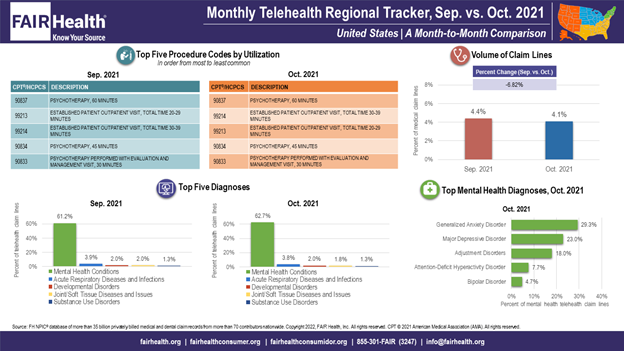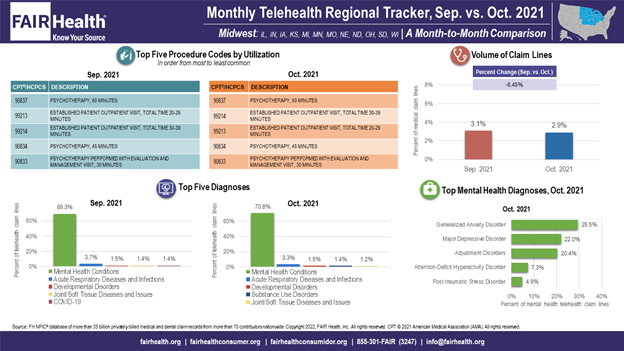- Center on Health Equity & Access
- Clinical
- Health Care Cost
- Health Care Delivery
- Insurance
- Policy
- Technology
- Value-Based Care
Decline Seen in National Telehealth Utilization in October 2021
After 2 months of growth, national telehealth utilization declined in October 2021, according to FAIR Health’s Monthly Telehealth Regional Tracker (FIGURE 1). Telehealth utilization, measured as a percentage of all medical claim lines, fell 6.8% nationally from September to October 2021, decreasing from 4.4% of medical claim lines in September to 4.1% in October. By comparison, telehealth utilization rose approximately 2% nationally in each of the months August and September. The data represent the privately insured population, including Medicare Advantage and excluding Medicare Fee-for-Service and Medicaid.
FIGURE 1. Monthly Telehealth Regional Tracker, September versus October 2021, United States
Credit: FAIR Health

A decline in telehealth utilization was seen in all regions in October except for the Northeast, where telehealth utilization remained stable at 4.8% of medical claim lines. The greatest decline, 11.4%, occurred in the South.
From September to October 2021, mental health conditions, which remained the top-ranking telehealth diagnosis nationally and in every region, increased in percentage share of all telehealth claim lines nationally (by 1.5%) and in every region. Similarly, the procedure code CPT 90837, 60-minute psychotherapy, increased as a share of all telehealth claim lines nationally and in every region by about 1%, while remaining the top-ranking procedure code nationally and in every region.
In October 2021, COVID-19 dropped out of the top 5 telehealth diagnoses in the Midwest, the only region where it had ranked in the top 5 in September (FIGURE 2). As a result, COVID-19 was no longer in the top 5 telehealth diagnoses nationally or in any region in October. In that same month, substance use disorders joined the top 5 at number 4 in the Midwest. The Midwest joined the Northeast in having that condition among its top 5 telehealth diagnoses.
FIGURE 2. Monthly Telehealth Regional Tracker, September versus October 2021, Midwest
Credit: FAIR Health

In October 2021 in the South, encounter for examination joined the top 5 telehealth diagnoses at number 3, while joint/soft tissue diseases and issues dropped out of the top five.
About the Monthly Telehealth Regional Tracker
Launched in May 2020 as a free service, the Monthly Telehealth Regional Tracker uses FAIR Health data to track how telehealth is evolving from month to month. An interactive map of the four US census regions allows the user to view an infographic on telehealth in a specific month in the nation as a whole or in individual regions. Each infographic shows month-to-month changes in volume of telehealth claim lines, top 5 telehealth procedure codes and top 5 telehealth diagnoses (or diagnostic categories), along with that month’s top 5 granular diagnoses within the most common diagnostic category.
As the COVID-19 pandemic and telehealth utilization continue to evolve, FAIR Health’s Monthly Telehealth Regional Tracker serves as a window into that evolution. This is one of the many ways we pursue our healthcare transparency mission.
For the Monthly Telehealth Regional Tracker, click here.
Author Information
Robin Gelburd, JD, is the founding president of FAIR Health, a national, independent nonprofit organization that serves as a trusted leader in health care cost transparency, data analytics and benchmarks. FAIR Health possesses the nation’s largest collection of private health care claims data, which includes over 35 billion claim records and grows at a rate of over 2 billion claim records a year. Certified by CMS as a national Qualified Entity, FAIR Health also receives data representing the experience of all individuals enrolled in traditional Medicare Parts A, B and D. Gelburd is a nationally recognized expert on health care policy and health literacy and transparency. Selected as one of Crain’s 2019 Notable Women in Health Care, she has been invited to speak to organizations and federal and state agencies across the country and world.
